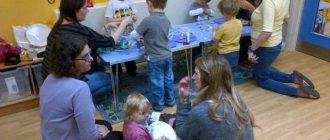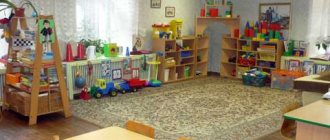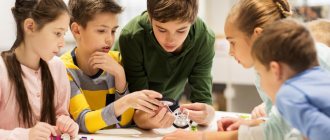In 2020, the requirements for educational standards have changed, so you will have to work longer than usual on the annual plan. Due to the pandemic and updates to the law, 5 major tasks need to be added to the plan.
We recommend that you start preparing your plan with new items, because they will take the most time. If you have already drawn up a plan without taking into account new tasks, write them down on the adjustment sheet:
- Last year's goals
- Remote technologies
- Anti-terrorism protection
- Networking
- Parent Consultation Center
- Approval and control of the annual plan
Approval and control of the annual plan
When a new annual plan has been drawn up, all tasks have been spelled out and their executors have been appointed, you need to agree on the final version of the plan. Usually it is agreed upon with the teaching council. To do this, send an electronic version of the plan to employees the day before the meeting so that they have time to familiarize themselves and prepare their proposals and questions. If disagreements arise at the meeting, revise the plan accordingly. If the teaching council has no objections, put the stamp “Approved”.
After the plan is approved, new tasks must be communicated and instructions issued to everyone involved in their implementation. Then you can post the annual plan on the official website. If you decide to publish it, please exclude from the public version any information that should not be shared publicly. For example, information about working with official documentation or details of the anti-terrorist protection plan for preschool educational institutions.
Once the team begins implementing the plan, monitor its progress at a monthly meeting. To do this, it is convenient to create a checklist in which employees will note what they have completed and what they have not. In this sheet you need to register the reporting activities, performers and deadlines.
If you found this article helpful, please rate it on the star scale below, with 5 stars being very helpful.
We want you to read only interesting materials, and we will be grateful for your feedback!
Current trends in modern education in preschool educational institutions article
Current trends in modern education in preschool educational institutions
Relevant trends of modern education in preschool educational institution
UDC 3 37.37.01/.09 37.02
This article discusses current trends in preschool educational institutions: smart learning, educational robotics, learning outside of class, educational games, social media, STEAM.
In this article modern trends in preschool educational institution are considered: smart training, educational robotics, training out of occupations, educational games, social media, STEAM.
Keywords: trends, education, technology, STEAM, smart learning, educational robotics, educational games, social media, training, classes.
Keywords: trends, education, technologies, STEAM, smart training, educational robotics, educational games, social media, training, occupations.
The 21st century is the century of globalization, new technologies and innovations, the century of new thinking and a new attitude to the changes taking place. The dynamism and interdependence of the ongoing changes dictate the need for a new approach to the education system. Trends in education are trends in its change.
Let us pay attention to the trends of the Federal State Educational Standard for Educational Education in order to correlate them with the possibilities of the considered educational trends[3].
1. The Federal State Educational Standard for Educational Education is based on a system-activity approach. It is necessary to individualize each child, regardless of his characteristics.
2. The main goal of the Federal State Educational Standard for Preschool Education is the full development of the individual based on the formation of universal educational actions, mastering and knowing the world (in the form of games, cognitive and research activities, creative activity).
3. The innovative nature of the standards is the requirements for the conditions for the implementation of education.
4. Educational areas, as well as activities outside the classroom, appear in the plans.
5. The Federal State Educational Standard for Education puts educational technology at the forefront. Over the past decade, the education system has been actively introducing pedagogical innovations and computer teaching methodologies in order to improve the quality of education and its results.
6. Value guidelines in the Federal State Educational Standard for Educational Education are shifted: from community and collectivism to individualization, from cognitive activity to socialization.
Over the past decade, the education system has been actively introducing pedagogical innovations and computer teaching methodologies in order to improve the quality of education and its results.
Smart learning is the first learning trend consisting of the merging of online distribution of software and content in the form of multimedia.
The main goal of Smart education is to create an environment that provides a high level of competitive education through the development of students’ knowledge and skills of modern society of the 21st century: cooperation, communication, social responsibility, the ability to think critically, quickly and efficiently solve problems [1, p.1 ].
The second trend is educational robotics, which takes a modern approach to introducing elements of technical creativity into the pedagogical process through the combination of design and programming.
Robotics classes provide opportunities for diversified development and formation of the most important competencies outlined in the new generation standards:
- skills in conducting experimental research: putting forward hypotheses, searching for solutions, conducting observations and measurements, establishing cause-and-effect relationships, assessing the influence of individual factors, processing and analyzing results;
- development of creative, imaginative, spatial, logical, critical thinking;
- development of communicative competence: teamwork (in pairs, groups) to develop and implement ideas, plan and implement activities, develop vocabulary and communication skills.
Learning outside of class is the third trend. This is a format of learning through activities, which may include research and application of knowledge in practice. Such training can take place in the form of a game, a quest, geocaching, photo hunting, or a hike. At the same time, children and their parents are “immersed” in history, culture, and nature, since certain tasks are set and appear before them.
The fourth trend in modern education is social media. The social service Facebook, Google services and tools, the Wiki website, podcasts for distributing sound files or videos on the Internet, blogs, YouTube video hosting - all this can and should be used in the classroom.
In conducting leisure, entertainment, games, and matinees, multimedia tools perform a special task: they clearly convey the thematic content of the event, accompany it with sound and light effects, which certainly increases the quality level of the event.
The introduction of educational games into teaching is the fifth trend of our time. Serious educational games are created for a variety of educational areas. There is, for example, a game that simulates the process of climate change, or a medical game to solve an environmental problem, and the like.
One of the main trends in global education is STEAM. The sixth trend is a new educational technology that combines several subject areas as a tool for developing critical thinking, research competencies and group work skills.
The abbreviation STEAM stands for:
S – science,
T – technology,
E – engineering,
A – art,
M – mathematics.
Or natural sciences, technology, engineering, creativity, mathematics - disciplines that are becoming the most popular in the modern world. Instead of studying each of the five disciplines separately, STEAM integrates them into a single learning framework.
At the International Conference “STEAM forward”, which was held in 2014 in Jerusalem, the following statements were made: “Involving children in STEAM. This education should begin from a very early preschool age, and therefore it is necessary to introduce programs in kindergartens[5].”
An important feature of working with this technology is the collective work on the project. STEAM – allows you to use the right hemisphere of the brain, which is responsible for creativity, emotions, and feelings. There are many examples of successful design work using this technology.
And no matter how successful traditional methods of education and training may be, modern reality requires the search for new and effective forms.
Instill the skills of independent learning throughout life, teach interaction at different levels, develop independent and critical thinking - these and many other principles constitute the strategy for the development of modern educational technologies[4].
If we are preparing our children for later life, then we must allow them to use those tools that will still become part of their daily life in the future.
Bibliography:
1.Ten A.S. and others. Smart training in the system of advanced training for teachers. Toolkit. -Almaty: JSC NTsPK "Orleu". 2014. -112 p.
2. Case Thurlow. Ten trends in modern education URL: https://www.hse.ru/news/media/63841790.html
3.Trends of modern education. Features of educational trends
URL: https://sites.google.com/site/trendsofedu/fgos
4. The course “Modern educational technologies and SMART” is your guide to new opportunities for using ICT in the classroom. URL: https://edguru.ru/blog/edutrends/
5. Tamara Strelnikova. What is STEAM education?
URL: https://www.unikaz.asia/ru/content/chto-takoe-steam-obrazovanie
Teaching children to learn
It is impossible to prepare for any one profession, if only because it has not yet been invented. This means that the most important thing is to teach children to learn and develop character qualities that will be useful everywhere.
Soft skills and emotional intelligence are popular today. But does everyone understand what it is, how to develop it and, most importantly, how it will help children in adulthood?
Neuropsychologist Erin Claybow says that emotional intelligence is, first of all, the ability to empathize. Empathy, the second name for emotional intelligence, comes in two types: emotional and intellectual. It is impossible to teach the first: tears or joy for another person are simply a reaction of our limbic system. But the second one is a real “superpower”. By teaching a child to understand how another person feels, we give him the power to literally “penetrate” his consciousness. What does this give? Oh, there are tons of possibilities here! This includes analyzing the causes, predicting results, the ability to find a common language with anyone, and adapting to the interlocutor or the situation so that everyone wins, understanding one’s own feelings, and building personal boundaries.
The main advantage, according to Professor Claybow, is that intellectual empathy allows a child to predict the future. There is no magic: knowing how your interlocutor feels, it is easier to find words to support him, console him or, conversely, put him in his place, without unnecessary melodrama and conflict.
How to teach this? And again, nothing supernatural. Start with the basics: discuss how the heroes of fairy tales and cartoons feel and what they are thinking now, and then ordinary people from everyday circles. How can you help in a difficult situation? What would the child do if he were in the place of the one who got into trouble? How will the hero most likely behave and why did the child make this conclusion?
Digital hygiene
What are parents' biggest fears in the face of technology? Once they get sucked in like that, you can’t get them out. That virtual reality will become more attractive than real life. That someone out there, inside the global network, can deceive or offend a child.
So, playing together is also an excellent prevention. How will a child understand that this is an aggressive and angry game if you leave him alone with it? How will he know that enough is enough if you yourself are constantly “surfing”? How will he learn to recognize deception and bad intentions online if the interlocutor on the other side of the screen offers him something exciting, and you don’t ask anything at all, except whether the child washed his hands and learned the verse for the matinee?
Technology is a tool that you need to learn to use. In themselves they are neither harmful nor beneficial. And the parent should teach how to use it - by example, devoting time, attention and patience and showing HOW you should really treat this tool.
Technology in education is a beast that needs to be tamed and studied.
You can find out exactly how to do this at the EDCRUNCH 2022 conference.






